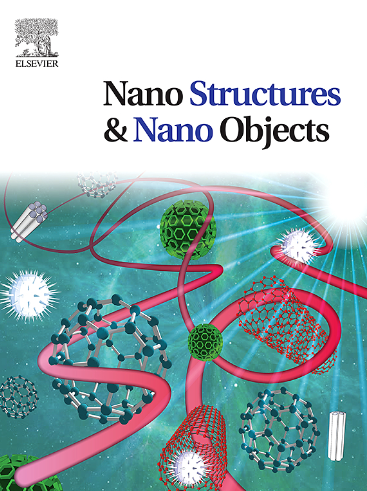Synergistic effect of AgNPs and gentamicin: Inhibition of multi-drug resistance bacterial biofilm formation and down-regulated fim H gene
IF 5.45
Q1 Physics and Astronomy
引用次数: 0
Abstract
Antibiotic resistance poses a significant public health concern, particularly in treating urinary tract infections (UTIs) caused by multi-drug resistant (MDR) Gram-negative bacteria. This study presents a novel approach to enhance the antibacterial activity of Gentamicin (Gent) against Proteus mirabilis and Klebsiella pneumoniae through the innovative creation of a silver nanoparticles (AgNPs) nanocomposite, termed Gent@AgNPs, using an environmentally friendly pulsed laser ablation technique. The morphology, size, and elemental composition of the silver nanoparticles (AgNPs) were examined using several analytical techniques, including (ZP.DLS, SEM, UV–vis spectroscopy, FT-IR, XRD, and TEM). The results confirmed that the hetero nanocomposite, consisting of silver nanoparticles and gentamicin, exhibited greater antimicrobial activity compared to gentamicin alone against two types of bacteria P. mirabilis and K. pneumonia. The mixture of silver nanoparticles with gentamicin was produced to enhance the drug delivery method to inhibit the growth of K. pneumonia and P. mirabilis, and also prevent the formation of bacterial biofilms on foley catheters. The smartly hybrid nanocomposite displayed an improvement, suggesting that in the future its potential as a viable therapeutic strategy against P. mirabilis and K. pneumonia. Additionally, it could be a promising approach to avoid the growth of bacterial biofilm formation during urinary tract infections (UTIs).
AgNPs与庆大霉素的协同作用:抑制多重耐药细菌生物膜形成及膜H基因下调
抗生素耐药性是一个重大的公共卫生问题,特别是在治疗由多重耐药(MDR)革兰氏阴性细菌引起的尿路感染(uti)方面。本研究提出了一种新的方法来增强庆大霉素(Gent)对奇异变形杆菌和肺炎克雷伯菌的抗菌活性,通过使用环境友好型脉冲激光烧蚀技术,创新地创造了银纳米颗粒(AgNPs)纳米复合材料Gent@AgNPs。使用几种分析技术(包括(ZP))对银纳米颗粒(AgNPs)的形貌、大小和元素组成进行了检测。DLS, SEM, UV-vis, FT-IR, XRD, TEM)。结果证实,与单独使用庆大霉素相比,由纳米银颗粒和庆大霉素组成的异源纳米复合材料对两种细菌的抗菌活性更强。制备了纳米银颗粒与庆大霉素的混合物,以增强给药方式,抑制肺炎克雷伯菌和神奇假单胞菌的生长,并阻止foley导管上细菌生物膜的形成。巧妙混合的纳米复合材料显示出一种改进,表明在未来,它有可能作为一种可行的治疗策略,对抗神奇杆菌和肺炎克雷伯菌。此外,它可能是避免尿路感染(uti)期间细菌生物膜形成生长的一种有希望的方法。
本文章由计算机程序翻译,如有差异,请以英文原文为准。
求助全文
约1分钟内获得全文
求助全文
来源期刊

Nano-Structures & Nano-Objects
Physics and Astronomy-Condensed Matter Physics
CiteScore
9.20
自引率
0.00%
发文量
60
审稿时长
22 days
期刊介绍:
Nano-Structures & Nano-Objects is a new journal devoted to all aspects of the synthesis and the properties of this new flourishing domain. The journal is devoted to novel architectures at the nano-level with an emphasis on new synthesis and characterization methods. The journal is focused on the objects rather than on their applications. However, the research for new applications of original nano-structures & nano-objects in various fields such as nano-electronics, energy conversion, catalysis, drug delivery and nano-medicine is also welcome. The scope of Nano-Structures & Nano-Objects involves: -Metal and alloy nanoparticles with complex nanostructures such as shape control, core-shell and dumbells -Oxide nanoparticles and nanostructures, with complex oxide/metal, oxide/surface and oxide /organic interfaces -Inorganic semi-conducting nanoparticles (quantum dots) with an emphasis on new phases, structures, shapes and complexity -Nanostructures involving molecular inorganic species such as nanoparticles of coordination compounds, molecular magnets, spin transition nanoparticles etc. or organic nano-objects, in particular for molecular electronics -Nanostructured materials such as nano-MOFs and nano-zeolites -Hetero-junctions between molecules and nano-objects, between different nano-objects & nanostructures or between nano-objects & nanostructures and surfaces -Methods of characterization specific of the nano size or adapted for the nano size such as X-ray and neutron scattering, light scattering, NMR, Raman, Plasmonics, near field microscopies, various TEM and SEM techniques, magnetic studies, etc .
 求助内容:
求助内容: 应助结果提醒方式:
应助结果提醒方式:


